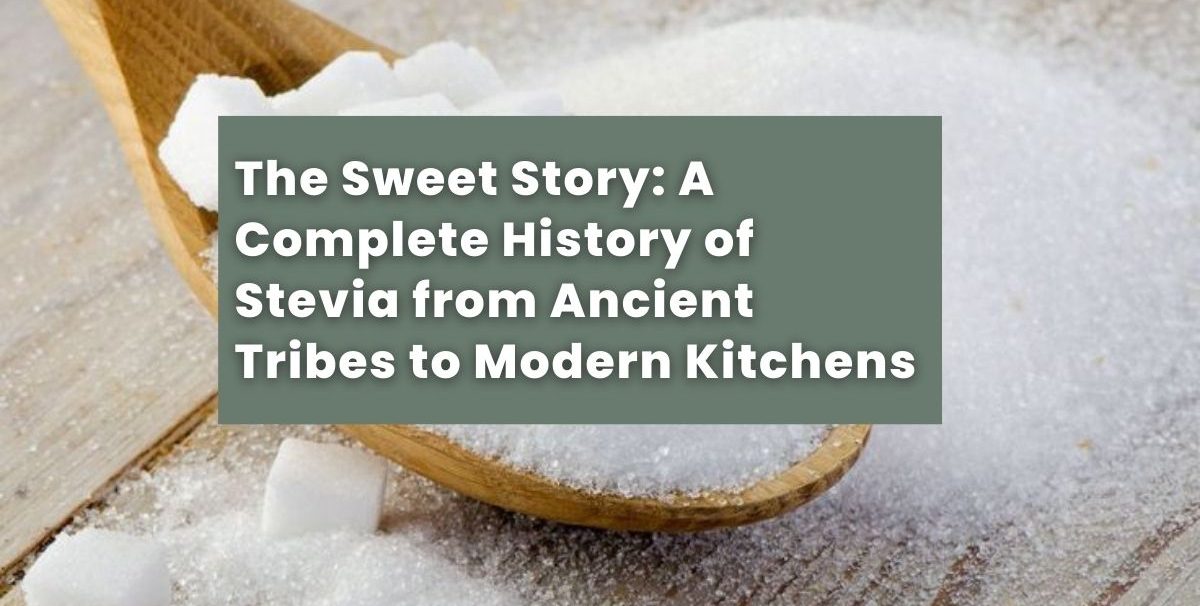What Is Stevia? A Natural Sweetener with Ancient Roots
Stevia—heard the name, savored the sweetness, but always wondered where it comes from? Stevia is a plant-based sweetener extracted from the leaves of Stevia rebaudiana, a tiny, herbaceous plant native to South America. For those who are entering the history of stevia, it’s not another health trend—it’s a botanical tale filled with cultural depth, indigenous knowledge, and worldwide transformation.
As the planet turned towards health-focused substitutes, stevia became a leading contender, not just because of its zero-calorie sweetness, but due to its centuries-long reputation as nature’s own candy leaf.
Stevia Origin: Where Did This Sweet Leaf Come From?
The stevia journey starts in Paraguay and Brazil’s fertile soil. The Guaraní tribe, the indigenous people of that region, were the first to cultivate and consume the stevia plant. Generations went by while this leaf was not only a sweetener but a part of their everyday life, loved for its taste as well as for its medicinal properties.
The Guaraní Tribe and the Sacred Leaf
To the Guaraní, stevia was known as ka’a he’ê—which literally means “sweet herb.” They used it to sweeten yerba mate, a local tea, and as a natural remedy. This indigenous use of stevia laid the foundation for what would become one of the most revolutionary plant-based sweeteners globally.
How Was Stevia Used by Ancient Tribes?
Traditional uses of stevia in South America were more than just flavoring. It was utilized in conventional medicine as well for treating ailments like indigestion, heartburn, and infections. The fresh leaves were chewed, soaked in water, or thoroughly dried to make them into a powdered form for further use. This considerable amount of usage reveals the cultural significance of stevia, both as a natural sweetener and healer.
Traditional Medicinal Uses of the Stevia Plant
Long before the pharmaceutical industry became aware, indigenous people knew stevia’s antibacterial and anti-inflammatory qualities. Healers would prescribe it as a tonic to stabilize blood sugar and calm skin irritations. In short, stevia in traditional medicine was worth as much as gold dust in tribal rituals and remedies.
Discovery of Stevia: When Europe Got a Taste
The Western world remained blissfully unaware of stevia for centuries—until the late 1800s, when European explorers ventured deep into South American jungles and stumbled upon this miracle leaf.
The Role of Moisés Santiago Bertoni
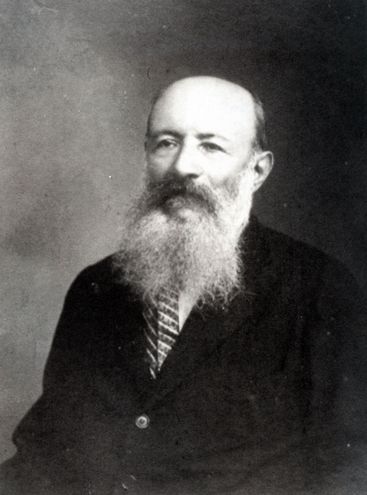
Moisés Santiago Bertoni, a Swiss botanist who was the first to provide a scientific description of the stevia plant in 1899. Curious about its sweetness and the fact that the local people relied on it, Bertoni documented the characteristics of the plant and brought international attention to it. His paper was a valuable milestone on the timeline of the history of stevia discovery.
Historical Timeline of Stevia Discovery and Use
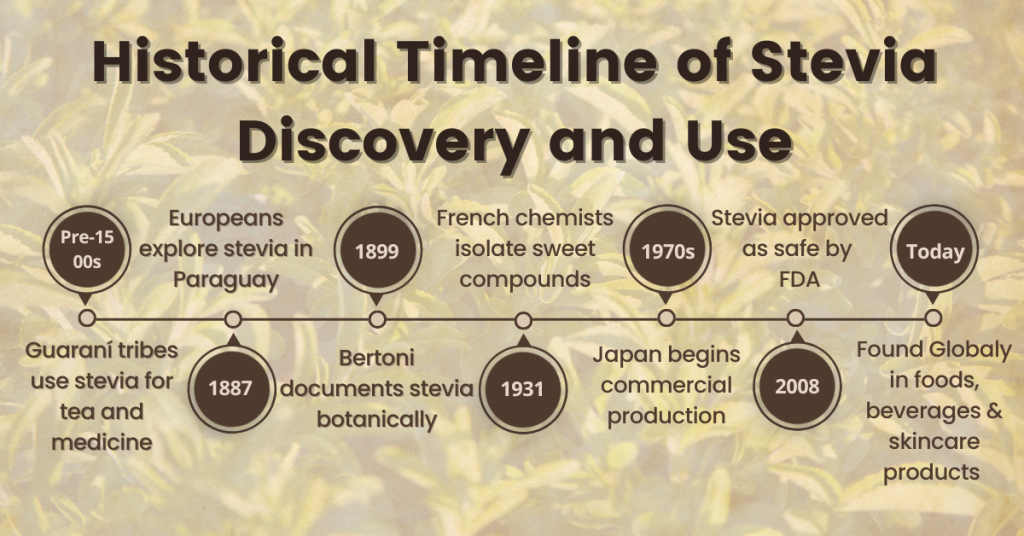
| YEAR | EVENT |
| Pre-1500s | Guaraní tribes use stevia for tea and medicine |
| 1887 | Europeans explore stevia in Paraguay |
| 1899 | Bertoni documents stevia botanically |
| 1931 | French chemists isolate sweet compounds |
| 1970s | Japan begins commercial production |
| 2008 | Stevia approved as safe by the FDA |
| Today | Found in foods, beverages, and skincare products globally |
Stevia’s Evolution from Herb to Sweetener
The history and development of stevia from herb to sweetener is not only captivating but also tactical. It was a local secret for centuries, until the scientific world opened floodgates for the global community. As soon as steviol glycosides—the primary sweet compounds of the plant—were purified, their commercial value became apparent. These glycosides, Rebaudioside A and Stevioside, are the reason stevia is so uniquely sweet, being up to 300 times sweeter than sugar without spiking blood sugar or calorie levels.
This advantage was the turning point in the history of stevia as a natural sweetener. Unlike man-made substitutes such as aspartame or saccharin, stevia preserved its plant origin. Health-conscious brands began to manufacture stevia extracts at different purities and blends, satisfying customer demands while preserving the integrity of the leaf.
Food giants Coca-Cola and PepsiCo were quick to take advantage. Their diet and zero-calorie drinks started carrying stevia-based sweeteners, so the plant became familiar to households. By the early 2010s, you could find stevia in everything from low-carb protein bars and green juices to toothpaste and skincare products. This dramatic shift wasn’t only scientific—it was also cultural. With the increased trend toward natural and sustainable products, stevia’s clean label status made it a favorite choice of wellness experts and green consumers alike. That’s how stevia gained fame as a sweetener, and why it remains the leading player in the plant-based sugar substitute category.
Scientific Studies and Sweetness Factors
Recent research confirmed the sweetness and health-promoting effects of stevia. Scientists proved Stevia’s efficacy in diabetes management, weight loss, and sugar reduction. Its safety profile also positioned it as a good sugar alternative for millions.
In 2010, an FAO/WHO joint expert committee affirmed steviol glycosides to be safe for regular consumption, providing the basis upon which regulatory authorities such as the FDA would affirm it as GRAS (Generally Recognized As Safe). It was a historic achievement in bringing stevia to a healthy sweetener.
Some trials also examined the potential of stevia to decrease caloric intake when consumed instead of sugar. Individuals who drank stevia-sweetened drinks reported lower daily caloric consumption and reduced cravings, affirming its value for weight reduction and dietary control. Other research indicates stevia could possess antioxidant and anti-inflammatory capabilities, which would make it a sweetener beyond a functional food ingredient—it might be a functional food ingredient itself. Yet more research is still being conducted to reveal the entire extent of its medicinal possibilities.
Regulatory Milestones and Global Acceptance
Japan led the way in adopting stevia during the 1970s, long before Western countries approved it. Today, it is recognized and approved by food safety authorities like the FDA, WHO, FSSAI, and the European Food Safety Authority, cementing its status as a global staple.
How Stevia Became a Sugar Substitute Worldwide
The shift toward natural, non-GMO, and clean-label foods drove the adoption of stevia on a global scale. With rising cases of diabetes, obesity, and metabolic disorders, governments began regulating sugar content in packaged foods. In response, food manufacturers turned to stevia as a natural sweetener that could meet both consumer demand and legal guidelines.
Countries like Japan, South Korea, and Brazil were early adopters. In Japan, stevia has been widely used since the 1970s, long before the West embraced it, often featured in soft drinks, chewing gum, and pickled vegetables.
In the United States and Europe, initial skepticism slowed its adoption. But once regulatory clearances came through, stevia became mainstream. Today, it’s found in hundreds of global brands and is part of dietary trends like:
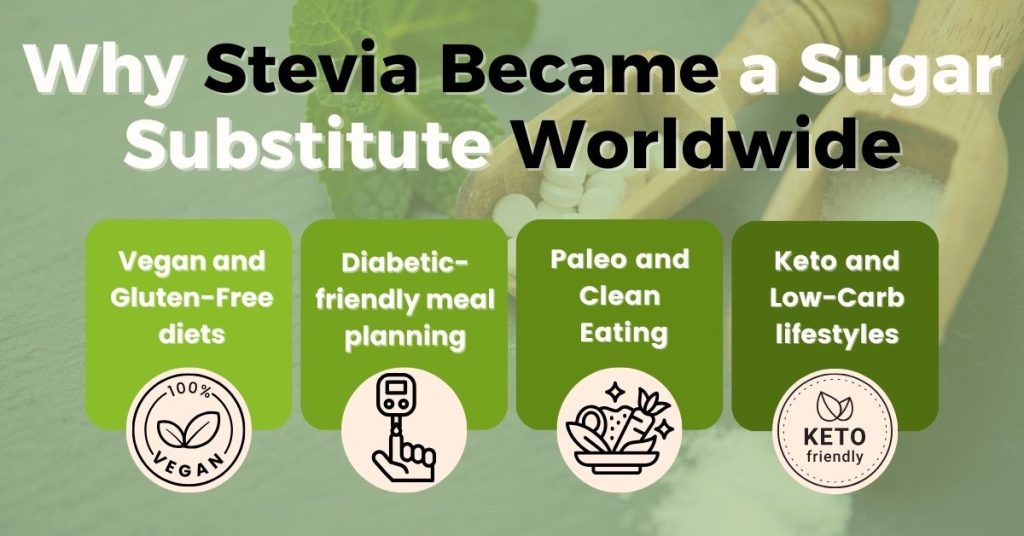
- Keto and Low-Carb lifestyles
- Paleo and Clean Eating
- Vegan and Gluten-Free diets
- Diabetic-friendly meal planning
Stevia’s ability to replace sugar without changing flavor or texture makes it an indispensable tool in modern food innovation. Even home bakers now use it in cakes, cookies, and beverages—bringing the sweet story of stevia full circle, from ancient medicine to culinary magic.
Cultural History Behind the Stevia Plant
Let’s take a deeper look at the cultural history behind the stevia plant. For the Guaraní tribe, stevia was more than functional—it was sacred. They didn’t just use it for flavor or health; they believed it held spiritual power. Elders often referred to it during rituals, blessings, and storytelling sessions, considering it a gift from the gods to sustain and heal their people.
Its use wasn’t random. Tribal knowledge about when to harvest the leaves, how to dry and prepare them, and which ailments they addressed was passed down orally, generation after generation. This indigenous use of stevia played a pivotal role in how the plant was preserved and eventually discovered by Western botanists.
Even today, in parts of Paraguay and Brazil, communities still grow and use stevia in traditional ways—often side-by-side with modern stevia cultivation farms. That duality highlights the plant’s enduring appeal: it’s a cultural legacy and a modern marvel rolled into one.
Why Ancient Tribes Valued Stevia Leaves
So, why did ancient tribes value stevia leaves so highly? Part of it was practical—stevia helped flavor bitter teas and improve digestion. But another part was spiritual. Many tribes saw plants as having personalities and intentions, and stevia’s sweet taste was seen as a symbol of harmony, love, and healing.
They also noticed how stevia helped wounds heal faster or how a simple tea could soothe a sore throat. Over time, the leaf became synonymous with comfort, a natural remedy to life’s daily stresses. That’s how traditional medicinal uses of the stevia plant are intertwined with cultural meaning. Even in modern ethnobotany, stevia stands as a prime example of how indigenous knowledge paved the way for sustainable health solutions. We owe much of its popularity today to those early stewards of the land who understood the power of plants long before the world caught on.
Conclusion: A Sweet Future Rooted in History
Stevia’s journey from ancient tribal teas to the shelves of health stores is nothing short of magical. From indigenous use of stevia to its rise as a global, zero-calorie sugar substitute, this plant has crossed time, culture, and science to earn its place in our kitchens. And as more people choose wellness over sweetness, stevia proves that the best solutions often come from the roots—literally.
Did You Know This About Stevia?
Stevia is eco-friendly, requiring less water and land compared to sugarcane or beets.
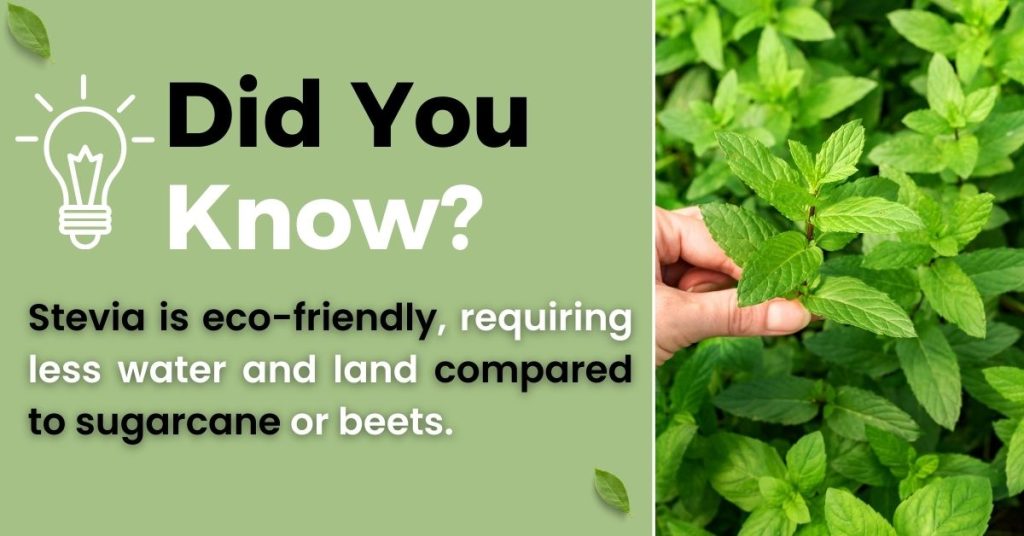
FAQs About the History of Stevia
Q1: How was stevia used by ancient tribes?
A1: Tribes used stevia leaves in teas, as sweeteners, and in medicine for skin ailments and digestion.
Q2: Where did stevia originate from?
A2: Stevia originated from South America, primarily Paraguay and Brazil.
Q3: What is the stevia plant in medicine?
A3: It was traditionally used to treat heartburn, infections, and regulate blood sugar levels.
Q4: Who discovered stevia for the modern world?
A4: Swiss botanist Moisés Santiago Bertoni is credited with classifying the plant in 1899.
Q5: How did stevia become a sugar substitute?
A5: After studies confirmed its sweetness and safety, countries like Japan commercialized it as a sugar alternative in the 1970s.
Q6: What makes stevia different from artificial sweeteners?
A6: Stevia is plant-based and natural, with no artificial chemicals or calories.
Q7: Can we consume stevia daily?
A: Yes, stevia is safe for daily use when consumed in moderation. It’s a natural, zero-calorie sweetener approved by health authorities.






